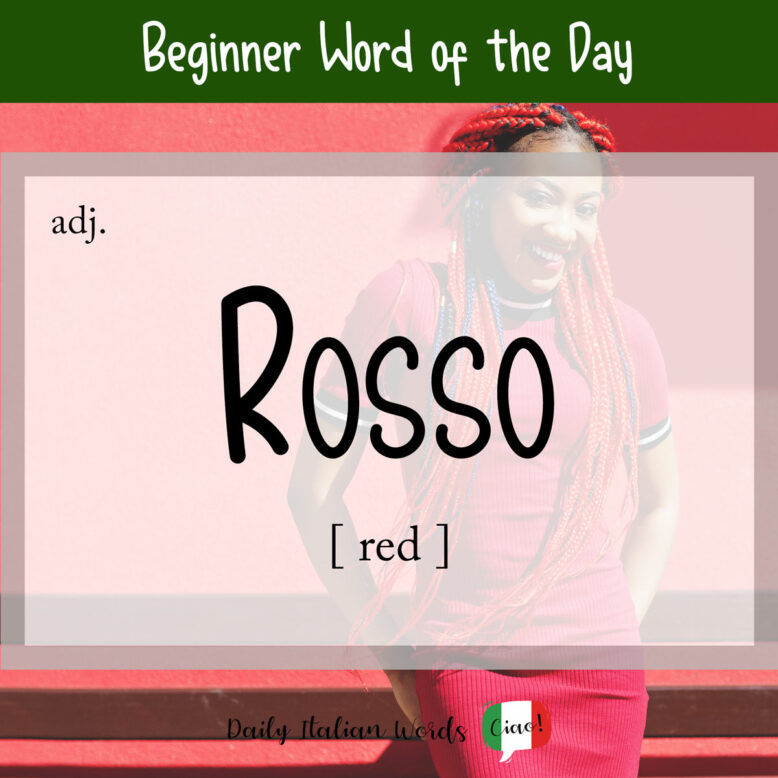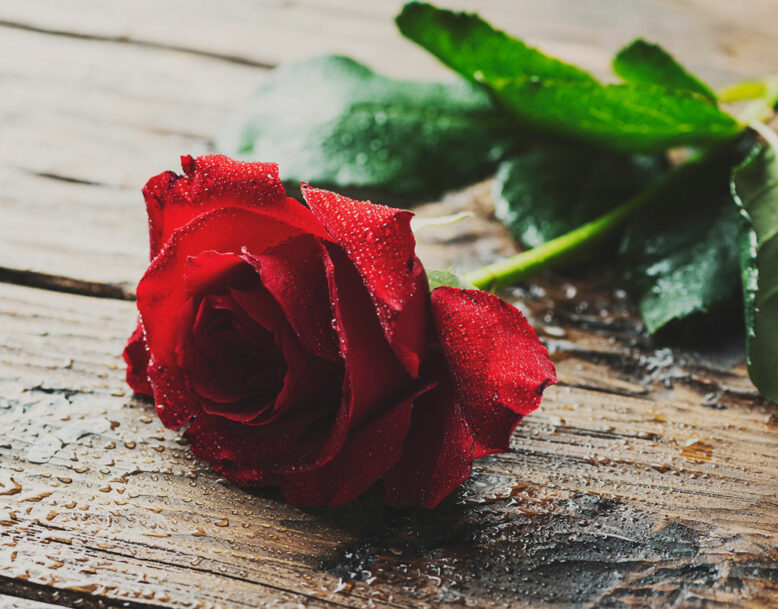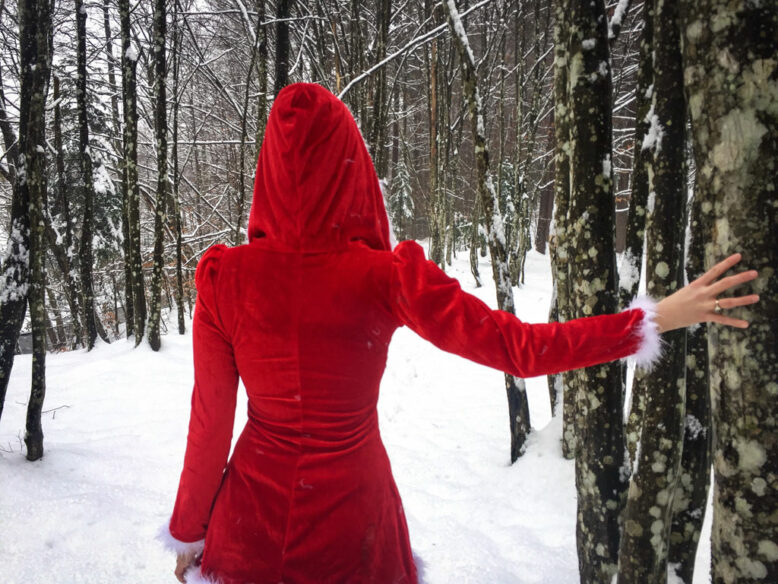The Italian word for the colour red is rosso. It comes from the Latin russus of the same meaning.

Because it is an adjective, the ending changes in accordance with the gender and/or plurality of the subject. For example:
- un cappello rosso = a red hat
- una gonna rossa = a red skirt
- cappelli rossi = red hats
- gonne rosse = red skirts
Important: The pronunciation of the feminine form rossa mustn’t be confused with another colour, rosa, which means pink or rose. The single ‘s‘ in rosa is pronounced as if it were a ‘z‘.
Le regalò una rosa rossa per San Valentino.
He gave her a red rose for Valentine’s Day.

The word rosso is often used in a figurative sense to indicate things that are a) reddish in colour or b) associated with danger. A few good examples include:
- semaforo rosso = red traffic light >> can be abbreviated to just rosso as in the phrase passare col rosso (to jump a red light)
- a luci rosse = pornographic >> the red-light district is called quartiere a luci rosse in Italian, a reference to the red neon lights that highlight the windows where the women work
- rosso d’uovo = yolk >> can be abbreviated to just rosso, also known as tuorlo d’uovo
- vino rosso = red wine >> can be abbreviated to just rosso as in the phrase bere un bicchiere di rosso (to drink a glass of red wine)
- pizza rossa / pasta rossa = pizza or pasta with tomato sauce
- rosso = Communist / Red >> for example, armata rossa refers to the army of the Soviet Union
- essere in rosso = to be in the red, to be in debt
Nel quartiere a luci rosse, un signore, alla guida di una Testarossa, è passato con il rosso dopo aver bevuto troppi bicchieri di rosso.
In the red-light district, a gentleman, driving a Ferrari Testarossa, jumped a red light after drinking too much red wine.

Whereas people with red hair are called red-heads in English, Italians simply say rosso (for a man) and rossa (for a woman). Note that there is also another adjective for this: fulvo / fulva.
When talking about someone who is blushing (diventare rosso) due to embarrassment or shyness, you can use any of the following comparative idioms to describe their appearance:
- rosso come un pomodoro = as red as a tomato (may also refer more generically to someone with a red face)
- rosso come un peperone = as red as a bell pepper (may also refer to burnt skin or a red nose resulting from a cold)
- rosso come il fuoco = as red as fire (may also refer to burnt skin, beautiful lips / cheeks, or a feverish complexion)
- rosso come un gambero = as red as a shrimp (may also refer to burnt skin or a person’s ruddy appearance after physical exertion)
- rosso come un papavero = as red as a poppy
Non appena la vide, diventò rosso come un papavero.
As soon as he saw her, he went as red as a poppy.
If you say that someone has a red nose (naso rosso), the implication is that they are cold, or have had too much to drink.
If you catch too much sun, you can say that you have le spalle rosse (red shoulders) or la schiena rossa (red back) for example.
Some etymologically related terms include:
- rossiccio = ruddy, reddish
- rossetto = lipstick
- rossore = redness, blushing, flushing
- rossastro = reddish
- rosseggiare = to redden, to become red
Did you know that…?
In Italian, Rossi is by far the most common surname, so the name Sig. Rossi is often used in sample business letters, school textbooks and so on as a placeholder name (much like Mr. Smith or John Doe in English) for a generic Italian man. In fact, there is even an Italian cartoon called Signor Rossi, created by Bruno Bozzetto, whose eponymous protagonist is called as such because he could literally represent anyone (watch an episode below).
Did you know that…?
A famous European fairytale that has been translated into many languages is Cappuccetto Rosso (Little Red Riding Hood). Interestingly, its origins can be traced back to several 10th century European folk tales, including one from Italy called La Finta Nonna (The False Grandmother). In this version of the tale, the girl goes to visit her nonna but in her place she finds an orchessa (female ogre). The child realises that the ogre isn’t her grandmother, so she tricks her into leaving the house and makes her fall into a river.

How do you say “colors” in Italian and what is their name?
In this lesson, you’ll learn the Italian word for “color” along with the most common colors.
I’ll also show you 12 very popular expressions with colors that Italian uses in their daily life!
Ready? Let’s go!
THE COLORS IN ITALIAN
A life in black and white would be pretty boring, don’t you agree?
So let’s talk about the Italian colors!
Today, you’ll learn first how to say the word “color” in Italian; then we’ll see how to call the most common colors – I’ll break them down by categories so they’re easier to remember.
Finally I’ll show you 12 popular phrases with colors that Italians use pretty often.
There’s a lot to learn, so let’s go!
HOW DO YOU SAY THE WORD “COLOR” IN ITALIAN?
Let’s start from the basics. If you want to talk about the colors, then first you need to know how to say the term color … pretty obvious right?
So what is the Italian word for color?
In Italian you call it: “colore” on the singular and “colori” on the plural. If you want to add the article, it becomes: IL COLORE/I COLORI.
Now a question for you … did you recognize the gender of this word?
Is “colore” masculine or feminine?
If you’ve already checked my lessons on the word gender and the Italian articles, I’m sure you recognized the gender of this noun!
The term “color” is masculine.
So generally, when you use the color as a noun you always refer to it in the masculine form. For instance: “il rosso e’ un bel colore”, meaning that the red is a nice color.
However, if you use the color as an adjective to describe things, then they’ll have the same gender of the noun.
Look at the examples below:
- Il libro e’ rosso (the book is red) – the word “libro” in Italian is masculine and hence the color will be in the masculine form as well.
- La mela e’ rossa (the apple is red) – “la mela” in Italian is feminine and therefore the word “rossa” also agree with its gender.
Out of curiosity, colors not always change their gender when used as adjectives … sometimes they are the same in the masculine or feminine form. But you’ll find out more about it in the next paragraph so keep on reading!
HOW THE COLORS ARE CALLED IN ITALIAN?
Now that you know how to say the word “color” in Italian, you can learn how the colors are actually called.
I’ve listed below the main colors in Italian and split them in different categories to make it easier to remember.
You can learn it all at once or one at the time .. it’s up to you!
1. NEUTRAL COLORS
Let’s start with the ones classified as neutral colors. In Italian, you call them: COLORI NEUTRI.
These are the colors that you can use in combination with basically any colors without being an eyesore! Generally, this category includes the following:
- Black = NERO (m.) / NERA (f.)
- White = BIANCO (m.) / BIANCA (f.)
- Gray = GRIGIO (m.) / GRIGIA (f.)
- Brown = MARRONE (m./f.)
As you can see, they end in “o” in the masculine form and in “a” when refer to a feminine noun. However, the color brown doesn’t change: you always say “marrone” regardless of the gender.
2. COOL COLORS
In the second category, I’ve listed the ones known as cool colors (COLORI FREDDI).
According to psychologists these colors can evoke a sense of calm and peace. So they are often used in some environments like the bedrooms to help with relaxation. They include the following:
- Blue = BLU (m./f.)
- Light blue = AZZURRO (m.) / AZZURRA (f.)
- Green = VERDE (m./f.)
- Purple = VIOLA (m./f.)
In this section, only the color “light blue” changes based on the gender: “azzurro” in the masculine and “azzurra” in the feminine. Azzurra is also a name for girls, but it’s not very common.
3. WARM COLORS
Let’s move to the warm colors that in Italian are called COLORI CALDI. These are normally associated with the sun or the fire and that’s why their name. They include the below:
- Red = ROSSO (m.) / ROSSA (f.)
- Yellow = GIALLO (m.) / GIALLA (f.)
- Orange = ARANCIONE (m./f.)
Here both the colors red and yellow will be different depending on the gender: if you refer to a masculine noun they will end in “o” (rosso/giallo) while they get an “a” when in the feminine form (rossa/gialla). The orange, instead, doesn’t change and it will always be “arancione”.
4. OTHER COLORS
To finish up our list of colors, let’s see the remaining colors that didn’t fall in the above categories.
- Pink = ROSA (m./f.)
- Beige = BEIGE (m./f.)
- Fuchsia = FUCSIA (m./f.)
All the colors above are the same no matter the gender of the noun they refer to.
Some useful words about the colors ….
So we’ve seen the most common colors and how you say them in Italian.
However, before we move on, let’s see some other useful words that you can use when talking about the colors.
– ACCESO
You use the term “acceso” to say that a color is bright. So for example, “rosso acceso” means that the red is vivid.
– SBIADITO
“Sbiadito” means “faded” and you use it when the color is all but intense.
– COLORATO
When something is colorful, you can call it “colorato”. For instance, “una borsa colorata” means that the bag has many colors.
– CHIARO
This word, “chiaro”, is for describing the tonality of a color and means “light”. So for example: “verde chiaro” means light green.
– SCURO
“Scuro” is exactly the opposite than “chiaro” and hence means dark. “Giallo scuro” means that that yellow is not light.
– FOSFORESCENTE
This is another term to talk about colors and means “fluorescent”. For example “giallo fosforescente” is a type of yellow.
COMMON ITALIAN EXPRESSIONS WITH COLORS
To conclude this lesson, I’m going to show you 12 very common expressions that Italian use with colors.
Keep reading to find out what they are and what they mean.
1 – Di che colore e’?
“Di che colore e’?” is the question that you use to ask: “what color is it?”.
In the plural you have to say: “di che colore sono?” (What color are they?).
You need the verb to be for it, which is “essere” in Italian.
If you don’t remember how to conjugate it, check out this lesson here.
2 – Sono al verde
“Sono al verde” means that you have no money.
You can emphasize it even more by saying: “sono completamente al verde” meaning that you’re completely broke.
3 – Sono verde dall’invidia
“Essere verdi dall’invidia” is another common expression that uses the color green. Here it means that you are so jealous that your face turned green.
It’s an interesting one where colors are often associated with feelings, but let’s move on to find out more!
4 – Sono nero
In this expression the black is used to describe the mood. If you say “Sono nero” then you are in an extremely bad mood.
5 – Vedo nero
This other example instead means that you’re pessimistic. “Vedo nero, in fact, literally means that you see everything in black and so in a negative way.
6 – Ho una fame nera
The last expression with the color black is related to a physical need. “ho una fame nera” means that you’re starving. “Fame” is the Italian word for hunger.
7 – Rosso come un peperone
Let’s move on to another color: the red. “Sono rosso come un peperone” is same as saying to blush. Literally means that you’re so ashamed or embarrassed that you became as red as a pepper.
8. Ho il conto in rosso
Another one with the color red. If you say “ho il conto in rosso” you mean that you’re bank account is completely empty. “Conto” is the Italian word for account.
9. Bianco dalla paura
The next example still use a color to describe a feeling. The color here is the white.
“Essere bianco dalla paura” means that you are terrified. Basically you’re so afraid that you turned white.
“Paura” is the Italian word for fear.
10. Notte in bianco
The next expression is still with the color white. “Passare la notte in bianco” means that you spent the night without sleeping well or you haven’t slept at all.
11. Bandiera bianca
Another one with the color white: “alzare bandiera bianca” means to raise the white flag. So in a figurative way it means that you’re giving up.
12. Nero su bianco
Finally, the last expression uses the color black and white but in a completely different context.
To put something “nero su bianco” means to write it down.
It’s very common to use for contracts or agreements especially when the parts are a bit suspicious.
In these situations, you ask to put everything in a written form to avoid any kind of misunderstanding.
Phrases and Vocabulary for Talking About Colors
Colorful small island of Burano in the Venetian Lagoon.
Federica Gentile / Getty Images
You want to tell your friend the color of the Vespa you want to buy, the type of wine you were drinking, or the hue of the sky while you were on a hilltop in Florence, but how do you say the colors in Italian?
To start, here are the most common thirteen along with a list of subtle and unique blends.
Basic Colors
Red – Rosso
- Lei porta sempre un rossetto rosso. — She always wears red lipstick.
Pink – Rosa
- Ho comprato un vestito rosa per la festa. — I bought a pink dress for the party.
Purple – Viola
- Ho dipinto le unghie di viola. — I painted my nails purple.
TIP: Unlike other colors, you don’t have to change the ending of “rosa” or “viola” to match the object it’s describing.
Orange – Arancione
- La sua macchina nuova è arancione ed è troppo sgargiante per i miei gusti. — Her new car is orange, and it’s too bright for my tastes.
Yellow – Giallo
- Stava leggendo un giallo con una copertina gialla. — He was reading a mystery novel with a yellow cover.
TIP: “Un giallo” is also a mystery novel or thriller.
Green – Verde
- Mi piace vivere in Toscana, in mezzo al verde. — I like living in Tuscany, in the middle of the green.
Blue – Azzurro
- Ho gli occhi azzurri. — I have blue eyes.
Silver – Argento
- Gli ho regalato un cucchiaio d’argento per la loro collezione. — I gifted them a tiny, silver spoon for their collection.
Gold – Oro
- Cerco una collana d’oro. — I’m looking for a gold necklace.
Gray – Grigio
- Il cielo è così grigio oggi. — The sky is so gray today.
White – Bianco
- Non voglio indossare un vestito da sposa bianco, ne preferisco uno rosso! — I don’t want to wear a white wedding dress, I prefer a red one!
Black – Nero
- Calimero è un pulcino tutto nero con un cappellino bianco in testa. — Calimero is a black chick with a white little cap on his head.
Brown – Marrone
- Mamma mia, lei è bellissima, ha gli occhi marroni e lunghi capelli castani. — Oh my goodness, she’s beautiful, she has brown eyes and long, brown hair.
TIP: You would use “marrone” to describe the color of someone’s eyes, like “gli occhi marroni”, and you would use “castano” to describe the color of someone’s hair “i capelli castani”.
Dark Colors
If you want to talk about dark shades, you can just add the word «scuro» at the end of each color.
- Dark red – Rosso scuro
- Dark green – Verde scuro
- Dark blue — Blu
TIP: “Blu” is understood all its own to be a darker shade.
Light Colors
Here are some lighter shades:
- Baby blue – Celeste
- Baby pink – Rosa confetto
- Light green — Verde chiaro
- Light blue — Azzurro
TIP: Like “blu”, “azzurro” on its own is usually understood as light blue.
Unique Colors
Shiny/glossy red – Rosso lucido
- Stavo pensando di comprare una Vespa di color rosso lucido, che ne pensi? — I was thinking about buying a shiny red Vespa, what do you think?
Vermilion red — Rosso vermiglione
- Rimango sempre affascinata dalla tonalità di rosso vermiglione dei dipinti di Caravaggio. — I’m always attracted by the red vermilion shade used by Caravaggio in his paintings.
Hot pink – Rosa shocking
- Non mi piacciono per niente i vestiti di colore rosa shocking, non sono eleganti. — I don’t like hot pink clothes at all, they’re not elegant.
Blue green – Verde acqua
- Mi sono innamorato dei suoi occhi verde acqua. — I fell in love with her blue green eyes.
Lilac – Lilla
- Il lilla è un colore davvero rilassante. — The color lilac is really relaxing.
Maroon – Bordeaux
- Il mio colore preferito è bordeaux. — My favorite color is maroon.
Hazel brown – Nocciola
- Ho comprato le lenti a contatto affinché potrei avere degli occhi color nocciola. — I bought contact lenses so that I could have hazel brown eyes.
Italian Expressions with Colors
- Heart of gold – Cuore d’oro
- Not all that glitters is gold. – Non è tutto oro quel che luccica.
- Sweet dreams – Sogni d’oro
- Black sheep (of the family) — La pecora nera
100
Italian for the number 5
What is «cinque»?
(cheen-kweh)
100
Italian word for white
What is «bianco»
100
English for «pantaloni»
What is pants?
100
English word for «nonna»
What is grandmother?
100
Italian for «hello» or «good day»
What is «Buon giorno!»
200
Next number in the sequence: sei, sette, _____
What is «otto»?
(oht-toh)
200
Italian word for green
What is «verde»?
200
English for «camicia»
What is shirt?
200
Italian Word for
city
200
Italian way to say «Thank you»
What is «Grazie»?
300
duet comes from this Italian number
What is «due»?
(2)
300
Italian word for red
What is «rosso»?
300
English for «calzino»
What is a sock?
300
Italian word for plaza
piazza
300
Italian way to say «You’re Welcome»
What is «Prego»?
400
«uno» plus «tre»
What is «quattro»?
400
English word for «arancione»
What is orange?
400
English for «cappello»
What is a hat?
400
Italian word for friend
What is «amico»?
400
Italian way to say «My name is»
What is «Mi Chiamo»
500
one more than «nove»
What is «dieci»?
500
Italian for the colors of the flag of Italy
What is «rosso» (red), «bianco» (white) and «verde» (green)?
500
English for «scarpe»
What are shoes?
500
Italian word for grandfather
What is «nonno»
500
English for «Come stai?»
What is «How are you?»
Click to zoom
1234567891011121314151617181920212223242526272829
Across
- 3. the Italian word for green
- 5. the Italian word for March
- 7. the Italian word for short
- 9. the Italian word for December
- 11. the Italian word for brown
- 12. the Italian word for July
- 14. the Italian word for fat
- 15. the Italian word for august
- 17. the Italian word for orange
- 21. the Italian word for hot pink
- 23. the Italian word for may
- 25. the Italian word for tall
- 26. the Italian word for January
- 28. the Italian word for red
- 29. the Italian word for April
Down
- 1. the Italian word for February
- 2. the Italian word for September
- 4. the Italian word for dark blue
- 6. the Italian word for November
- 8. the Italian word for October
- 10. the Italian word for light blue
- 13. the Italian word for small
- 14. the Italian word for June
- 16. the Italian word for yellow
- 18. the Italian word for black
- 19. the Italian word for thin
- 20. the Italian word for blue
- 22. the Italian word for purple
- 24. the Italian word for gray
- 27. the Italian word for white

